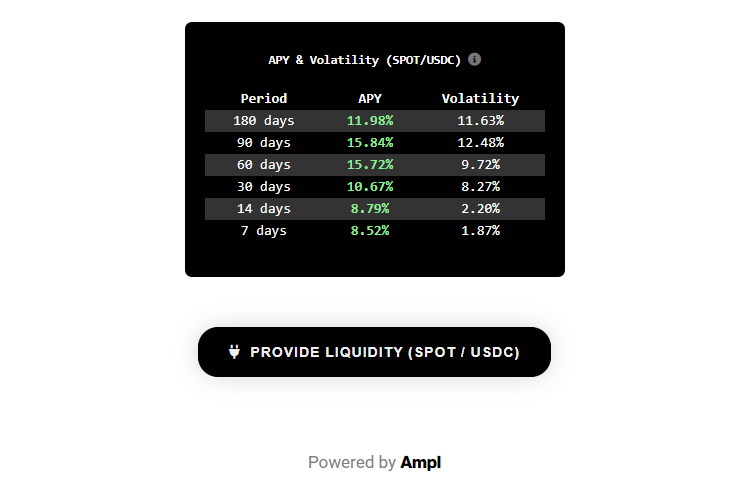Ampleforth is quietly building the future of money (and you're missing it)


The Ampleforth team recently tweeted an Ultimate Strategy Guide on September 10th, and it's packed with insights. But it's missing some huge developments that make Ampleforth way more interesting than most people realize.
The Base integration is real and massive
Here's what the guide mentioned that many people glossed over: "As the ecosystem grows (for instance, with Base integration, where Coinbase is supporting SPOT), we may see SPOT used in lending markets, as a stablecoin alternative in yield farms, or in payment scenarios where price stability is important."
Coinbase is actually supporting SPOT on Base. Think about the implications:
- First major exchange backing LVA over traditional stablecoins
- No bank reserves that can be frozen
- No blacklists or censorship risks
- Pure on-chain transparency
SPOT on Base could become the decentralized stablecoin alternative that DeFi has been waiting for.
The rotation vault is basically automated yield farming
The original guide explains the mechanics, but here's what it really means for regular users:
Old way: You had to manually time AMPL rebases and hope you got lucky
New way: Throw your AMPL in the vault and it automatically:
- Splits your risk between stable (SPOT) and volatile (stAMPL)
- Rotates positions weekly so you're always in fresh positions
- Collects fees from people who want leverage
- Compounds your gains without you lifting a finger
It's like having a really smart trader managing your position 24/7.
The vault fees now only flow to stAMPL holders
Here's a huge change that makes stAMPL way more attractive: "As of 2025, what is not unsigned is the distribution of collected vault fees (i.e., flash mints or redeems). All fees collected now permanently flow only to stAMPL holders."
This is massive. Before, fees could flow either direction based on demand.
Now:
- Every 4-5% flash swap fee goes to stAMPL holders
- Every vault interaction generates revenue for stAMPL
- It's real yield that doesn't depend on token printing
- stAMPL holders are literally becoming the house
The guide calls this "perpetual real yield accrual when taking on risk in the vault." That's not marketing speak - it's a fundamental change in how value flows through the system.
The expansion cycle example is mind-blowing
The guide drops this casual example: "From late 2023 to early 2024, AMPL's supply grew from ~25 million to over 240 million (nearly a 10x increase) while price was relatively flat over the long term. A holder through that period captured a 10x increase in the value of their network ownership."
Let that sink in. If you held AMPL through that expansion cycle, you 10x'd your network ownership while the price stayed stable. Your token count exploded, but each token maintained its purchasing power.
Most people see rebasing as confusing. But it's actually the most elegant way to capture network growth without relying on speculative price pumps.
This is what sets Ampleforth apart from everything else in crypto. Network growth translates directly to holder ownership expansion.
SPOT liquidity pools are the sweet spot

Here's something the guide explained perfectly about SPOT-based liquidity pools: "Pools featuring only stablecoins have minimal arbitrage opportunities and hence lower yield, while pools like USDC-ETH suffer from increased impermanent loss due to much higher volatility levels. SPOT-based pools are positioned in the middle to maximize pool activity while minimizing risk."
This is brilliant positioning.
SPOT gives you:
- More trading activity than boring stable/stable pools
- Way less impermanent loss than volatile pairs
- The perfect balance for LP returns
The guide specifically mentions USDC-SPOT as an example. You get minimal impermanent loss but higher pool trading volume since SPOT can swing slightly, creating arbitrage opportunities.
Why this matters more than you think
Most people see Ampleforth as some academic experiment.
But look at what's actually being built:
- A currency that can't be inflated away by central banks
- Yield opportunities that don't rely on unsustainable token emissions
- Institutional backing through coinbase/base
- Seamless integration with existing defi
We're watching the early stages of an alternative monetary system being built in real time.
The timing couldn't be better
With inflation concerns growing and stablecoin regulation tightening, algorithmic stability is looking less like a nice-to-have and more like a necessity.

Ampleforth spent years in the wilderness building these systems when nobody cared.
Now they have:
- Battle-tested protocols
- Multiple derivatives for different risk profiles
- Institutional partnerships
- Growing liquidity across multiple chains
What most people still don't get
Ampleforth isn't trying to be another speculative crypto token.
It's building infrastructure for a post-fiat world where:
- Money supply adjusts to demand algorithmically
- Stability doesn't require trusting banks or governments
- Yield comes from providing economic utility, not printing tokens
The 2025 developments aren't just upgrades. They're proof that this vision is actually working.
The bottom line
While everyone's chasing the next meme coin or waiting for ETFs, Ampleforth is quietly solving real monetary problems.
The rotation vault makes participation simple. Base integration brings institutional credibility. And the yield opportunities are only getting better as more people discover what they've built.
This isn't financial advice, but if you're not at least watching Ampleforth, you're missing one of the most interesting experiments in crypto.
The future of money might not look like what we expect. And Ampleforth is showing us what it could look like instead.

